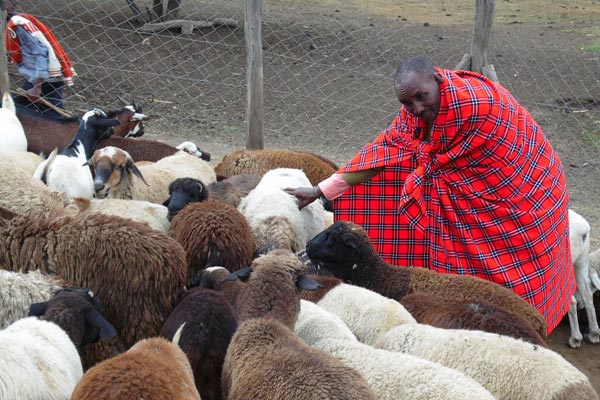Many livestock farmers in the Maasai community do not rear sheep for commercial purposes.
While a farmer may have up to 200 sheep and 100 cows, he will not count the former, which are reared for food and sentimental reasons.
But Joseph ole Partoip from Olopito, a few kilometers outside Narok Town, has gone against the grain.
He keeps sheep for cash and the wealth he is generating from them has made him ignore cattle, his people’s mainstay.
His healthy, clean, fast-growing Dorpers stand out.
They are bigger than the indigenous Red Maasai sheep and more disease-resistant than the Merino.
“I embraced the breed after learning about it in a farmers’ field day in Narok in 2001. Then I was keeping 20 Red Maasai sheep. I bought a Dorper ram at Sh10,000 from a farm in Isinya, Kajiado, and used it for crossbreeding with the Red Maasai.”
He phased out the Red Maasai slowly as he embraced the Dorper. “Sheep are prolific breeders. They calve down twice a year, with most of them delivering twins and triplets,” says the former chief who retired in 2002.
BIRTH TO QUADRUPLETS
Ole Partoip’s herd that has risen to 800 Dorpers once had 120 lambs within weeks after 40 sheep produced quadruplets. Farmers buy his at Sh6,000 each and rams at Sh30,000.
However, his main market is an abattoir in Narok, where he is a major supplier.
The Dorper was developed in South Africa and is a cross of the Dorset Horn and Blackhead Persian.
It was introduced locally through the Kenya Agricultural and Livestock Research Organisation (former Kari).
The animal is identified by its black head and white body. It does not have much wool as it naturally sheds off the little it has.
Ole Partoip grazes his animals on his 10 acres that he has divided into paddocks.
He buys fodder from different parts of Narok during the dry season.
The breed doesn’t require intensive management. He de-worms and sprays the animals and feeds them mineral supplements regularly to ensure they remain healthy.
Ole Partoip finds sheep-rearing economical as 10 animals can feed on what a single cow eats. “On average, I spend Sh500 on a sheep per month while a cow can take more than 10 times that amount in the same period.”
He sells 30 to 50 sheep after every three months, making between Sh250,000 and Sh350,000. Narok District Livestock Production Department has selected his farm to carry out the breeding of Dorper for sale to farmers.
“This encouraged me to channel my energies into this venture. I reduced the number of cattle to 10 from 137 to concentrate on sheep. I also keep 20 goats.”
In-breeding within the huge herd is Ole Partoip’s biggest challenge as it is difficult to monitor, which lowers the ruminants’ quality.
“But I have tried to overcome this by buying rams from a farm in Isinya. Each goes for up to Sh40,000,” he says.
Regular droughts also add pain to the farmer as he has to spend a lot of cash on fodder.
Narok North Sub-County Livestock Production officer Jamin Rutto says the Dorper offers more income than the other breeds because of its fast weight-gain.
CAUSES ABORTION
“If farmers want to reap big from sheep farming, then the Dorper is the way to go,” Rutto says.
He advises farmers to watch out for various diseases, including brucellosis, Rift Valley Fever, ruminal acidosis, pneumonia and bacterial meningitis, which causes abortion.
Signs of a sick sheep include withdrawal from others, frequent coughing, respiratory distress and rise in body temperature to over 54 degrees Celsius, from the normal 38.3, Rutto says.
source: daily nation








